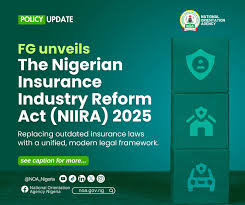INTRODUCTION TO THE NIGERIAN INSURANCE INDUSTRY REFORM ACT 2025
The Nigerian Insurance Industry Reform Act 2025 (NIIRA 2025) was signed into law by President Bola Ahmed Tinubu on August 5, 2025, marking a comprehensive overhaul of Nigeria’s insurance sector after nearly two decades since the Insurance Act of 2003. This legislation consolidates multiple outdated laws, including the Insurance Act 2003, Marine Insurance Act, Motor Vehicles (Third Party Insurance) Act, National Insurance Corporation of Nigeria Act, and Nigerian Reinsurance Corporation Act, into a unified framework to modernize the industry, boost economic growth, and address low insurance penetration (currently at 0.5% compared to higher rates in peers like South Africa). The Act, enforced by the National Insurance Commission (NAICOM), introduces risk-based supervision, enhances consumer protection, promotes innovation through technology (e.g., insurtech and electronic submissions), and aims to increase sector resilience amid economic challenges like inflation and currency fluctuations. Key objectives include protecting policyholders, fostering ethical practices, expanding financial inclusion (e.g., via micro-insurance, takaful, and agricultural insurance), generating employment, and enforcing compulsory insurances more rigorously to improve market conduct and public trust. The reforms are expected to drive sector growth, with stakeholders viewing it as a “game changer” for infrastructure financing and overall economic development. Key Reforms in the Act The NIIRA 2025 introduces several structural changes:
REVISED MINIMUM CAPITAL REQUIREMENTS: To ensure financial stability, insurers must meet higher capital thresholds based on risk profiles. Non-life insurers require at least ₦15 billion (or risk-based capital if higher); life insurers ₦10 billion; and reinsurers ₦35 billion. Existing firms have 12 months to comply, with NAICOM empowered to demand further increases based on business complexity. Consumer Protection and Funds: Establishes the Insurance Policyholders’ Protection Fund (funded by 0.25% of gross premiums) to safeguard claims in case of insurer insolvency. It also mandates timely claim settlements (within 60 days) with penalties for delays, and creates funds like the Fire Services Maintenance Fund (0.25% of net premiums from public building insurances) and Road Accidents Victims Compensation Fund. Regulatory Enhancements: Adopts a flexible “framework approach” for regulations, strengthens corporate governance, regulates holding companies, and imposes stricter sanctions (e.g., license suspension, fines up to ₦50 million, or imprisonment for unlicensed operations). Innovation and Inclusion: Recognizes fintech/insurtech in distribution, promotes digitization, and expands compulsory classes like the ECOWAS Brown Card Scheme for cross-border motor insurance. Compliance Obligations: Insurers must submit audited financials by June 30 annually, publish statements in newspapers, and file quarterly returns. Public entities face indirect obligations through mandatory insurances.
MANDATE ON INSURANCE FOR PUBLIC BUILDINGS A CORNERSTONE OF THE ACT IS THE STRENGTHENED enforcement of compulsory insurances, particularly for public buildings, to mitigate risks like fire, collapse, earthquakes, storms, and floods. This builds on suboptimal enforcement of prior compulsory classes and introduces new provisions for comprehensive coverage. Definitions and Scope
Public Buildings: Defined broadly to include tenement houses (more than one floor), hostels, buildings occupied by tenants/lodgers/licensees, and any structures accessible to the public for educational (e.g., schools), medical (e.g., hospitals), recreational (e.g., event centers), or business purposes (e.g., malls, offices). Buildings Under Construction: Applies to structures with more than one floor, covering liabilities from negligence by owners, contractors, or authorities leading to injury, death, or damage to workmen/public. Government Assets and Employees: Extends to all federal government assets and requires group life assurance for employees (minimum three times annual emoluments), with premiums paid at policy commencement.
Requirements
Coverage Details: Policies must insure against specified hazards and cover legal liabilities for property damage, bodily injury, or death to users/third parties. For construction, insurance must be procured upon building plan approval and before work starts. Insurers remit 0.25% of net premiums quarterly to the Fire Services Maintenance Fund for firefighting enhancements. Government-Specific: NAICOM sets regulations for risk assessment, ensuring stakeholder interests.
Penalties and Enforcement
Non-Compliance: Owners/occupiers face fines of at least ₦1-5 million, up to 12 months imprisonment, or both. Insurers failing fund remittances incur penalties up to 10 times the amount, with potential license cancellation. For government employees without coverage, employers pay three times emoluments upon death. Mechanisms: NAICOM can seal risky buildings, publish non-compliance notices, and impose administrative penalties. Appeals go to the NAICOM Board.
Implications and Reactions The mandate is poised to increase insurance penetration, reduce uninsured risks (e.g., building collapses), and potentially raise rents/costs as landlords pass on premiums. It supports infrastructure financing by mandating coverage for construction and public assets, fostering a more reliable industry with faster claims and better protection. Reactions are positive from NAICOM and operators like AXA Mansard, who see it as transformative, though concerns exist over implementation costs and enforcement challenges. Overall, the Act positions Nigeria’s insurance sector for global competitiveness and economic contribution.





